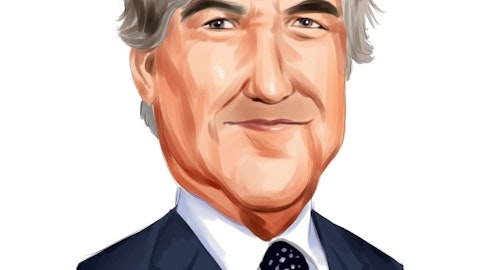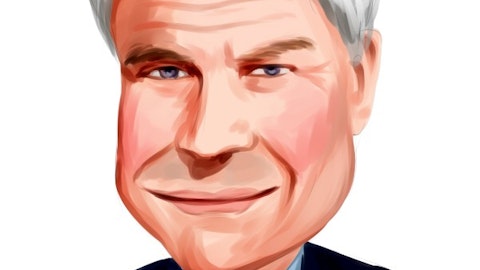Regency Centers Corporation (NASDAQ:REG) Q4 2022 Earnings Call Transcript February 10, 2023
Operator: Greetings, and welcome to the Regency Centers Corporation Fourth Quarter 2022 Earnings Call. At this time, all participants are in a listen-only mode. A brief question-and-answer session will follow formal presentation. As a reminder, this conference is being recorded. It is now my pleasure to introduce your host, Christy McElroy, Senior Vice President, Capital Markets. Thank you, Christy, you may begin.
Christy McElroy: Good morning, and welcome to Regency Centers’ fourth quarter 2022 earnings conference call. Joining me today are Lisa Palmer, President and Chief Executive Officer; Mike Mas, Chief Financial Officer; Alan Roth, Executive Vice President, National Property Operations and East Region President; Nick Wibbenmeyer, Executive Vice President, West Region President; and Chris Leavitt, SVP and Treasurer. As a reminder, today’s discussion may contain forward-looking statements about the company’s views of future business and financial performance, including forward earnings guidance and future market conditions. These are based on management’s current beliefs and expectations and are subject to various risks and uncertainties.
It’s possible that actual results may differ materially from those suggested by the forward-looking statements we may make. Factors and risks that could cause actual results to differ materially from these statements may be included in our presentation today and are described in more detail in our filings with the SEC, specifically in our most recent Form 10-K and 10-Q filings. In our discussion today, we will also reference certain non-GAAP financial measures. The comparable GAAP financial measures are included in this quarter’s earnings materials, which are posted on our Investor Relations website. Please note that we have also posted a presentation on our website with additional information, including disclosures related to forward earnings guidance.
Our caution on forward-looking statements also applies to these presentation materials. Lisa?
Lisa Palmer: Thank you, Christy, and good morning, everyone. Thank you for joining us. 2022 is a really good year for Regency, and we ended it on a high note with solid fourth quarter results on all fronts. Our strong performance is a testament to the quality of our shopping centers, the health and resiliency of our tenants and the hard work of our team. We enter 2023 with great momentum in our leasing pipelines fueled by strong tenant demand as we continue to have success growing rents across our portfolio. This persistent strength in the operating environment also continues to support the economics of our development and redevelopment projects. We look forward to further growing that pipeline over the next several years. At the same time, it is important to acknowledge that the challenging macroeconomic backdrop is bringing with it more tenant bankruptcies and early store closures, which have been relatively light for the last couple of years.
But importantly, our exposure to at-risk tenants is limited. This is not by accident. It is a product of many years of intentionally cultivating our portfolio of neighborhood centers and strong suburban trade areas. And where we do have exposure, we see upside opportunities in getting spaces back and taking advantage of the strong leasing environment. Additionally, with inflation moderating, along with some stabilization in the capital markets, we believe we have more clarity on the impacts to our business from the economic environment than we did three months ago. These factors underscore our conviction in our 2023 outlook. Shifting to the private transaction markets, we are starting to see increased activity. Transaction volumes remain thin, but with financing markets stabilizing and treasuries reversing course, competitive bidding situations are returning for high-quality grocery-anchored centers.
We believe this validates our portfolio and our investment strategy as shopping centers with a focus on necessity, convenience and value are more resistant to impacts from economic cycles. A couple of final thoughts before I turn it over to Alan. In addition to the stability and steadiness of grocery-anchored shopping centers, the open-air sector generally has really benefited from structural tailwinds coming out of the pandemic, lifting all boats with the rising tide. While we do expect those tailwinds to continue, we believe that 2023 can really shine a spotlight on Regency’s attributes, allowing us to separate from the pack. These attributes include the quality and locations of our real estate, our tenant credit, our balance sheet strength and liquidity and the hard work and dedication of our amazing team.
In our business, you win on the meaningful margin by making solid operating and investment decisions every day that generate steady and sustainable growth. It’s how we create value for our shareholders and this is reflected in Regency’s long track record of outperformance in cash flow and dividend growth. Alan?
Alan Roth: Thank you, Lisa, and good morning, everyone. The retail operating environment remains healthy, and we ended the year with another strong quarter. I’m really proud of our 2022 results. We had an exceptional year in leasing, helping to drive strong occupancy gains with our leased rate up 80 basis points and our commenced rate up 110 basis points over levels one year ago. Notably, our year-end 2022 same-property lease rate is back to our 2019 level of 95.1%. But make no mistake, we still have room to run and we aim to ultimately get back closer to peak levels of 96% or higher. The primary driver was our record year for shop space leasing ending the year up 200 basis points with our shop lease rate now 70 basis points above 2019.
I am especially proud of the shop occupancy recovery considering the many challenges we faced during the pandemic. Our tenant retention rate remains above historical averages, bad debt as a percent of revenues is back to pre-COVID levels. And importantly, our GAAP and net effective rent spreads were in the mid-teens for the year due to our team’s accomplishments of achieving initial cash rent spreads north of 7%, embedding contractual rent steps in the majority of our leases and maintaining our track record of judicious leasing capital spend. All of these positive trends and the progress we’ve made contributed to another strong year of same-property NOI growth of 6.3%, excluding COVID-related reserve collections and term fees. At year-end, our signed but not occupied pipeline of 230 basis points represents more than $34 million of annual base rent, giving us positive momentum into 2023.
Importantly, as leases commence, we continue to replenish this pipeline with newly executed leases. We have seen strong tenant demand continuing in the New Year, and our LOI and lease negotiation pipelines remain full. Our most active categories include restaurants, health and wellness, veterinary, grocers and off-price. We are hearing from top national retailers that their appetite to expand outpaces the quality inventory available today which bodes well for Regency’s high-quality portfolio. As we all know from recent headlines, tenant bankruptcies and early store closures will be more impactful as we think about move-outs in 2023. Among retailers that have recently filed for bankruptcy, Party City comprises only 20 basis points of ABR over 6 stores, and we have only one Regal Cinema, which is less than 10 basis points of ABR.
In the context of Bed Bath & Beyond’s recently announced store closures, at year-end, we had 11 stores comprising 60 basis points of ABR. We had one of those expire naturally in January, and of the closures announced last week, we had five locations on the list. Within our 2023 guidance range, we’ve embedded assumptions for credit loss associated with these bankruptcy filings and store closure announcements which Mike will discuss in more detail. But all of that said, we believe our overall exposure to at-risk tenants is relatively limited. Our current tenant base is healthier than ever as a result of being intentional in the centers that we own and thoughtful in our merchandising process. And whatever the outcome of the at-risk tenants, we feel really good about the quality of our real estate.
Tenant bankruptcies are a normal part of our business. And to the extent we get stores back from underperforming retailers, we have opportunities to mark-to-market rents and upgrade the merchandising mix at our centers. To that end, our teams are already negotiating with replacement tenants at higher rents for all of the known closures. In summary, our strong Q4 results and the trends we are experiencing today provide positive momentum into 2023. Nick?

Photo by Ronnie George on Unsplash
Nick Wibbenmeyer: Thank you, Alan. Good morning, everyone. Last year, we successfully executed on our development and redevelopment strategy. Even with pressures from rising construction costs, we continue to achieve solid returns on our investments that will provide earnings accretion in years to come. To that end, we completed more than $120 million of projects with over $100 million of those completions in the fourth quarter. These include East San Marco, our public-anchored ground-up development here in Jacksonville. The property is 100% leased and outperformed original expectations on all metrics, including timing, cost and rents. Carytown Exchange in Richmond, Virginia is another public-anchored ground-up development.
We split this project into two phases during the pandemic and recently completed construction on the second phase. We’ve had great leasing success at Carytown with tenants such as Torchy’s Tacos, Jenny’s Ice Cream, Burton’s Grill and Starbucks. Preston Oaks is the redevelopment of an HEB-anchored center in Dallas. We were able to significantly upgrade the center in the merchandising mix by adding vibrant new shop tenants, including Mendocino Farms, Heyday and Everybody, and the property is now 100% leased. Out at Serramonte Center, we completed the first two phases of our redevelopment project during the fourth quarter. These phases included the interior mall renovation as well as the addition of Chick-fil-A and Starbucks outparcels. Future phases of this project, including the addition of two exterior buildings and the redevelopment of the former JC Penney space are expected to start in the second half of 2023.
In addition to our completions, we’ve also made great progress on our in-process development and redevelopments, which totaled $300 million at year-end. Highlights include our Whole Foods-anchored Town & Country redevelopment in Los Angeles. We discussed this project in detail a quarter ago, but construction has commenced in the fourth quarter and demolition of the former Kmart building is nearly complete. Additionally, at our Glenwood Green development in Old Bridge, New Jersey, construction is on schedule with Target’s anticipated opening later this year, and we expect Shoprite to open in early 2024. The team continues to do an excellent job of managing costs and keeping our projects on time and on budget. In total, we believe our accretive development and redevelopment program remains on track to deliver $15 million of incremental NOI in 2023 and 2024.
Beyond our in-process projects, I’m really encouraged by the progress we’re making growing our shadow pipelines. We’re focused on building our pipelines through sourcing new ground-up development projects, new redevelopment projects through value-add acquisitions, as well as continuing to unlock redevelopment opportunities in our existing portfolio. We also continue to engage meaningfully with developers that are facing financing challenges, which could create additional joint venture opportunities. In totality, we have the key ingredients necessary to grow our program, including robust tenant demand, long-standing retailer relationships, experienced development teams in top markets around the country. Importunately, we have the ability to self-fund this growth with free cash flow.
We believe the combination of these capabilities are unequaled, and we look forward to sharing additional details as we advance these opportunities. Mike?
Michael Mas: Thank you, Nick, and good morning, everyone. I’ll take you through some highlights from our Q4 and full year results, then walk through our 2023 guidance and assumptions before ending with some color on our balance sheet position. Our strong performance last year was underpinned by growth in NOI and more specifically from base rent growth. Excluding the collection of 2020 and 2021 reserves, which I’ll refer to today as COVID collections, we delivered same-property NOI growth of 5.8% in the fourth quarter and 6.3% for the full year. Again, most importantly, we saw a 3.6% contribution from base rent growth in 2022, accelerating to 4.8% in the fourth quarter. This growth in base rent over the last year has been driven by contractual rent steps, mark-to-market on re-leasing, increases in occupancy and commencement of rent from redevelopment projects.
As Alan mentioned, our leased occupancy rate is now back to pre-pandemic levels, but our eyes are set even higher. COVID collections were about $2 million in the fourth quarter and totaled $20 million for the year. That’s down from $46 million in 2021. During the fourth quarter, we converted another 2% of our tenants back to an accrual basis of accounting from cash, and as a result, recognized nearly $5 million of non-cash income from the reversal of straight-line rent reserves. We ended the year with 7% of our tenants remaining on a cash basis of accounting. For uncollectible lease income, in 2022, we were close to our historical average of 50 basis points on current year billings by nearly all metrics but for some limited exposure to higher profile potential bankruptcies, our in-place tenancy is about as strong as it’s ever been.
Looking ahead to 2023 and after excluding COVID collections, we are guiding to core operating earnings per share growth of close to 4% year-over-year at the midpoint. We’d like to point you to Slides 5 through 8 in our earnings presentation, which I’m certain you’ll find extraordinarily helpful as you work through our outlook. We expect same property NOI growth, excluding COVID collections of 2% to 3%, which is the largest positive driver of earnings into 2023. The primary contributor continues to be base rent growth, driven by embedded rent steps, rent growth from new leasing and shop space commencement as well as the delivery of completed redevelopment projects. Importantly, our same-property NOI guidance range also assumes credit loss impact of roughly 75 to 100 basis points from anticipated tenant bankruptcies and early store closures, including from those tenants that Alan discussed.
This credit loss impact includes an assumption that current year uncollectible lease income will be modestly above our pre-pandemic average of 50 basis points as well as the potential for occupancy to end the year flat to lower — should bankruptcy-driven move-outs occur. Again, this range excludes any impact from COVID collections, which I’ll discuss in a minute. As you think about reconciling NAREIT FFO of $4.10 last year to a guided midpoint of $4.07 in 2023. Remember that this metric continues to be significantly impacted by COVID era accounting adjustments, including the collection of rents previously reserved as well as the impact on non-cash revenues from converting tenants from cash to accrual. Our operating fundamentals continue to strengthen, as they have in 2022 and as they are expected to continue this year.
And these pandemic-related items can mask our true growth in cash earnings. It’s important to take this a step further this morning as these two items meaningfully impact year-over-year comparability. First, we are anticipating lower COVID collections of $3 million in 2023 compared to $20 million last year. And second, we are also anticipating lower non-cash revenues of $36 million at the midpoint in 2023 compared to $47 million in 2022. Please note that we increased our full year non-cash revenue guidance from $30 million a quarter ago to account for new information, including an assumption that we will continue converting tenants to accrual accounting in 2023, as well as the likelihood that we will recognize accelerated below-market rent amortization triggered by the potential for bankruptcy-related store closures.
This is why we focus on core operating earnings, which strips out the noncash adjustments and also why we provide same-property NOI excluding COVID collections. With this added transparency, you can better see the underlying positive growth. Again, I encourage you to use the materials in our earnings presentation, as I’m certain you’ll find it very helpful in evaluating these impacts. The good news is that we are fast approaching the point where these COVID-related impacts will no longer create meaningful noise in our reported results. To finish and to pivot from guidance, we feel great about how we are positioned from a balance sheet perspective with one of the strongest in the REIT sector at a time when it matters most. Our leverage is at the lower end of our targeted range of 5 times to 5.5 times debt-to-EBITDA.
And we expect to generate free cash flow north of $140 million this year, self-funding our development and redevelopment commitments. While the financing markets have moved in our favor over the last 3 months, we have no need to access the capital markets this year. Our revolving credit line was undrawn at year-end, and we have no unsecured debt maturities until mid-2024. Our liquidity position and maturity profile provide us the ability to remain patient and act when we need and walk to. With that, we look forward to taking your questions.
See also 25 Safest Countries for Solo Female Travelers and 10 Most Advanced Countries in Battery Technology.
Q&A Session
Follow Regency Centers Corp
Follow Regency Centers Corp
Operator: Thank you. We’ll now be conducting a question-and-answer session. Thank you. Our first question is from Michael Goldsmith with UBS. Please proceed with your question.
Michael Goldsmith : Good morning. Thanks for taking for my questions. You have this nice chart in your presentation where you outlined the factors that drive your long-term organic same-property NOI growth algorithm of 2.5% to 3% to your 2023 guidance of same property NOI growth without termination fees or collections of reserves 2% to 3% is generally consistent with that. So maybe you can reconcile your long-term algorithm with what you’re expecting this year. Where are the moving pieces? And just does that mean that 2023 is setting up as a Regency average year? Thanks.
Michael Mas : Good question, Michael. Thank you for that. Let me color that up, and I think you’ll find that the algorithm still is intact. We are anticipating north of 3% growth this year and the also important base rent line item. And that’s largely being driven by the tremendous activity that the leasing team delivered, and we highlighted on the call, 200 basis points of percent lease coming out of the small shop arena total, 110 basis points of commenced occupancy increases really driving good solid base rent growth. Rent steps are playing a contribution there. Rent spreads from 2022 into 2023 redevelopment contribution. So all of those elements as you highlighted in our algorithm are there. That being said, there are some items that are dragging us down in 2023, one of which is our credit loss reserve.
So a touch higher on a sequential basis, 2023 over 2022. I spoke to that in the prepared remarks, we are accounting for and providing for the potential for bankruptcies, which would be in excess of what we experienced last year. And then there is a slight drag coming from the net recoveries line item as well. You may have noticed that, that spiked in the fourth quarter. It’s been a little bit elevated for the year, and some of that won’t recur going into next year. So on balance, I feel like the algorithm is still in place. Regency has set up extraordinarily well to deliver upon that growth profile. And we still have room to run from a leasing perspective and seeing that north of 3% base rent growth in ’23 is a real positive identifier.
Michael Goldsmith : And my follow-up is on the (inaudible) pipeline. Are you able to quantify how much is in there? And is that going to be realized by the end of 2023? Or is that a 2024 type of event?
Michael Mas : Let me start and if Alan wants to provide any color, he’ll jump in. It’s roughly $35 million of ABR. You can call that 4% of our in-place rents. So that’s — I’m speaking to the 230 basis points of SNO from a timing perspective, Michael, about 75%, 80% of that should be online by the third quarter of this year. And nearly all of it, in fact, by year-end, I think we’re in the 90% area for year-end.
Michael Goldsmith : Got it. Thank you very much. Good luck in ’23.
Michael Mas: Thank you.
Operator: Our next question is from Ki Bin Kim with Truist. Please proceed with your question.
Ki Bin Kim : Thanks. Good morning. So when you look at the inventory space that is left to lease across your portfolio, how would you describe the quality or leasability compared to what is currently occupied? Meaning there’s always typically space in every center that’s always harder to lease. So just trying to — I’m just trying to calibrate our expectations going forward.




